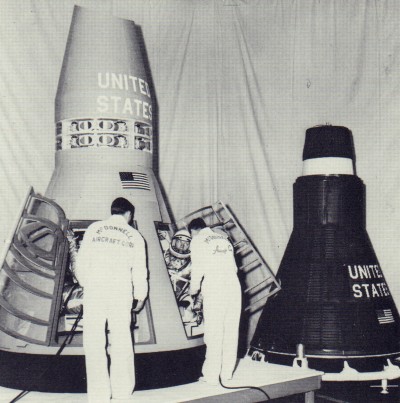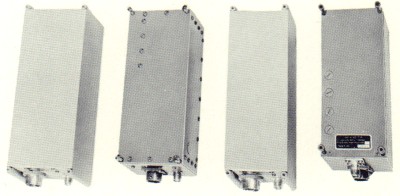|
|
|
| Collins Communication Selected for GEMINI | |
|
Project Gemini - America's intermediate step in landing a man on the moon - is an early means of experimenting with manned space rendezvous techniques and long duration flights. As the link between Project Mercury and Project Apollo, it employs a two-man craft capable of earth orbital flights of a week or more and thereby will provide pilot training for future circumlunar flights of long duration. Furnishing data on how man functions under prolonged conditions of weightlessness, these orbital flights will enable man to carry out a variety of scientific investigations in the space environment. Rendezvous in orbit is one way of carrying out later manned lunar landing missions while another possibility is the direct flight approach using a Nova booster. Currently, the most probable method of putting a man on the moon involves the use of the lunar orbit rendezvous in which a lunar excursion vehicle will be launched from the orbiting Gemini spacecraft for a one-man landing on the moon's surface. All methods are being explored in order to meet a national goal of a manned lunar landing by 1970 as outlined in the Apollo program. Voice communication aboard Gemini is being supplied by Collins under a contract awarded by McDonnell Aircraft, the prime contractor. The contract calls for at least 20 voice communication systems for the spacecraft. Collins will provide a UHF voice transmitter and receiver as the primary voice communication system. Also included will be a HF voice transmitter and receiver, the secondary voice communication system; a voice control center, which includes UHF and HF selector switches for the voice communication system and an intercom system for use by the two astronauts. |
 Mock-up of the two-man Gemini spacecraft (left) alongside a Mercury spacecraft shows size difference. Gemini is about 50 per cent larger and weighs two to three times as much as the Mercury vehicle. |
|
Equipment supplied by Collins for Gemini is basically similar to that designed and built for Project Mercury. The UHF and HF transceivers are about 15 per cent larger and weigh about 10 per cent more than the comparable Mercury radios. Basically, the size and weight increase is due to the increase in circuits required for Gemini. The principle of using UHF radio for space flight communication, advocated and proved by Collins engineers in Project Mercury, will be continued in Gemini. Similar manufacturing methods will be utilized so that the equipment will be able to withstand the vibration and shock of launch, space flight and re-entry. One difference in the Gemini and Mercury transceivers is that where the Mercury radios were mounted within the pressurized cabin, the Gemini radios will be outside the pressurized, or crew compartment, area. This means the Gemini equipment must be hermetically sealed to withstand the nearly perfect vacuum and the vast temperature differences of outer space. |
|
 Collins transceivers for Gemini (left, third from left) are compared with units used in recent Mercury flights. Left are HF Gemini and Mercury transceivers. Right are UHF transceivers. The Gemini radios are about 15 per cent larger and weigh about 10 per cent more. |
The Gemini spacecraft will be the same basic shape as the Mercury spacecraft but will be 50 per cent larger and will weigh two or three times as much as the Mercury vehicle. The design, in contrast to Mercury, installs many of the flight systems outside the crew compartment. Major components will be arranged on easily-removed shelves, thereby reducing maintenance and checkout time. Externally, the two-man vehicle without its adapter section will look much like the Mercury spacecraft, but the 16-foot escape tower will not be used. Ejection seats will be built into the Gemini to provide crewmen with a means of escape during launch or descent. The Gemini is scheduled to be boosted into orbit by a modified Titan II launch vehicle. The rendezvous target will be an Agena stage, similar to the vehicle used in Ranger and Discoverer projects. |
| —Collins Signal, Issue 47, Volume 10-3, 1962 - Page 19 | |